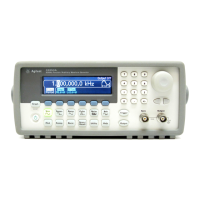142
Chapter 4 Remote Interface Reference
Simplified Programming Overview
4
Simplified Programming Overview
This section gives an overview of the basic techniques used to program
the function generator over the remote interface. This section is only an
overview and does not give all of the details you will need to write your
own application programs. Refer to the remainder of this chapter and
also the application examples in chapter 6 for more details. You may also
want to refer to the reference manual that came with your programming
application for further details on instrument control.
Using the APPLy Command
The APPLy command provides the most straightforward method to
program the function generator over the remote interface. For example,
the following command string sent from your computer will output a
3 Vpp sine wave at 5 kHz with a -2.5 volt offset.
APPL:SIN 5.0E+3, 3.0, -2.5
Using the Low-Level Commands
Although the
APPLy
command provides the most straightforward method
to program the function generator, the low-level commands give you
more flexibility to change individual parameters. For example,
the following command strings sent from your computer will output a
3 Vpp sine wave at 5 kHz with a -2.5 volt offset.
FUNC SIN Select sine wave function
FREQ 5000 Set frequency to 5 kHz
VOLT 3.0 Set amplitude to 3 Vpp
VOLT:OFFS -2.5 Set offset to -2.5 Vdc

